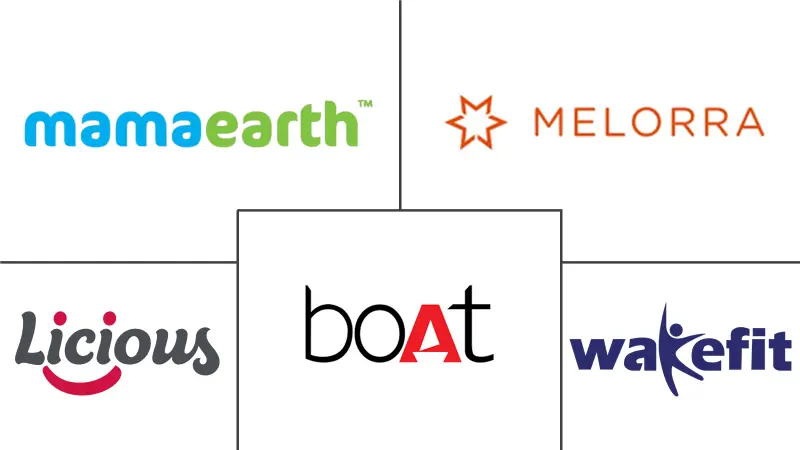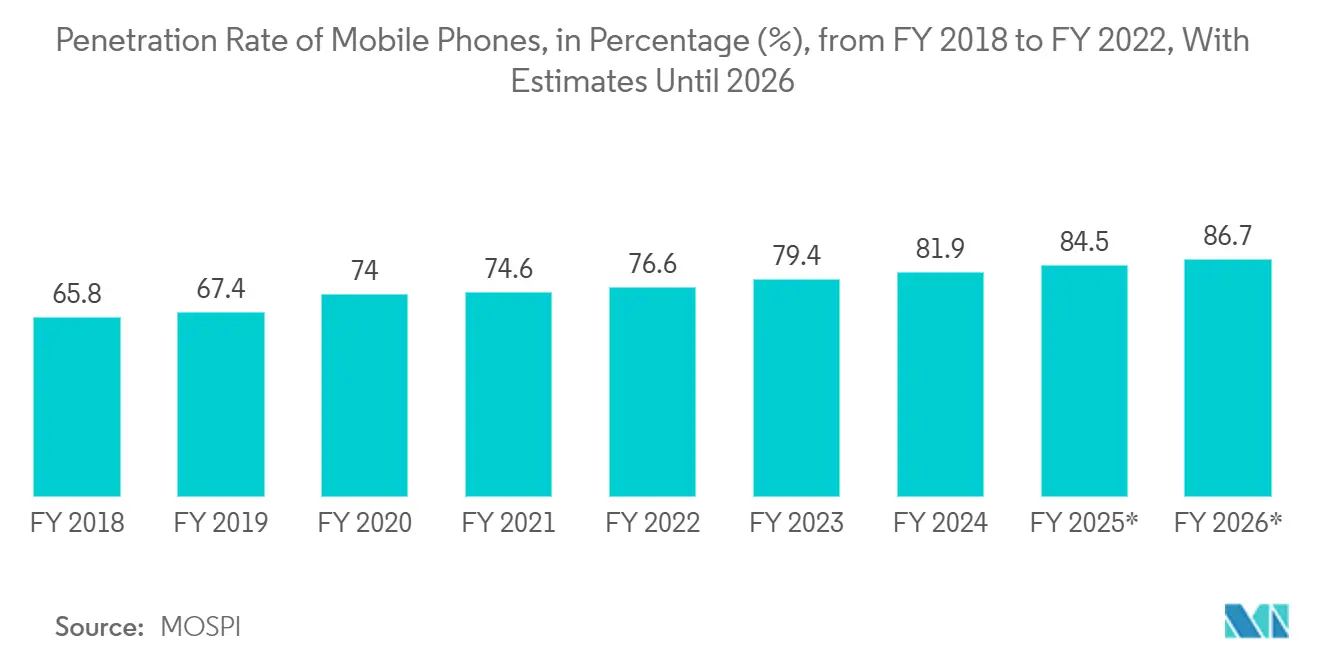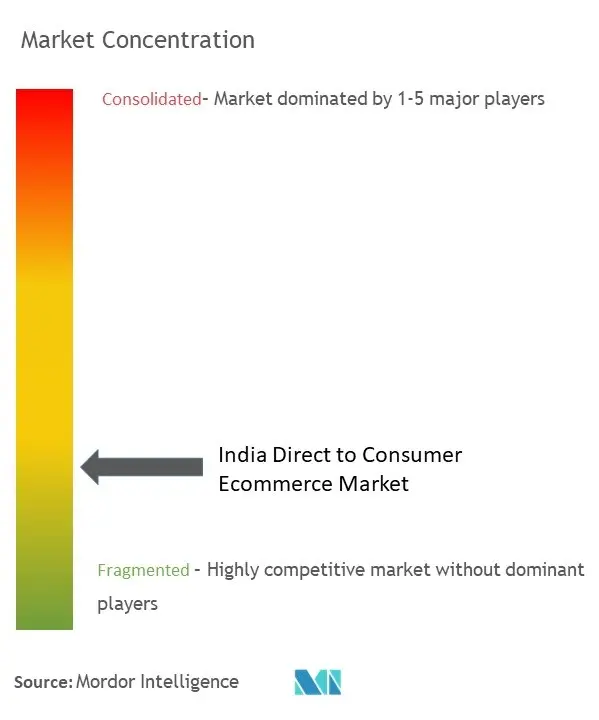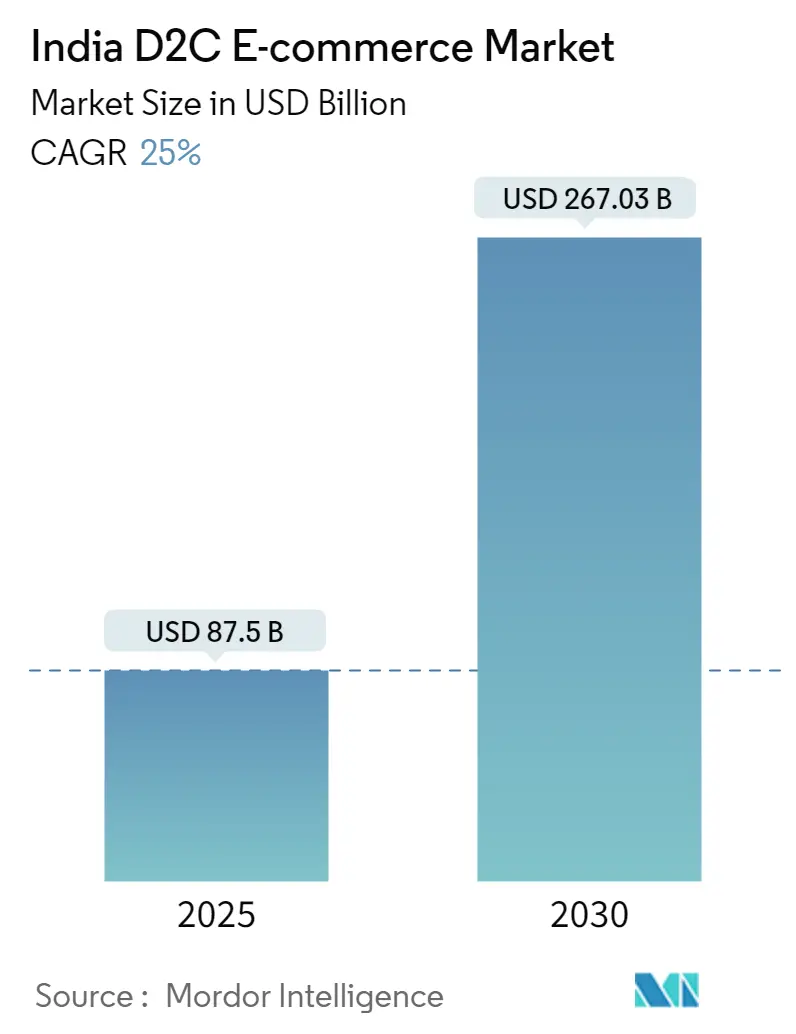
India D2C E-commerce Market Analysis
The India D2C E-commerce Market size is estimated at USD 87.5 billion in 2025, and is expected to reach USD 267.03 billion by 2030, at a CAGR of 25% during the forecast period (2025-2030).
- Direct-to-consumer (D2C) e-commerce is a business model where companies sell their products directly to buyers, bypassing traditional retail stores. This direct approach fosters direct communication between the buyer and the brand, fostering brand loyalty, understanding customer preferences, and driving repeat purchases. D2C e-commerce is pivotal, allowing manufacturers to sell directly to consumers via their online storefronts (referred to as business-to-consumer or B2C).
- Embracing a D2C e-commerce strategy empowers manufacturers with end-to-end control, spanning from packaging to marketing. With robust consumer spending and a surging e-commerce penetration rate, the Indian D2C market is poised for growth during the forecast period. Moreover, D2C platforms grant consumers the flexibility to purchase products of their preference, amplifying the allure of online shopping. As the appetite for digital e-commerce products grows, it further fuels the Indian market's momentum.
- The direct-to-consumer (D2C) model offers brands a wider range of choices for product testing. Brands have the ability to conduct pre-sales or introduce limited-time offers for specific products, beta test newly developed products, and decide on which products to manufacture, in what quantities, and where. Additionally, through the D2C model, brands can strategize their packaging, including sustainable packaging, to lower expenses, meet customer demands, and enhance their overall customer experience.
- In recent years, India's rising direct-to-consumer (D2C) business model has caused significant upheaval and change within the e-commerce industry. This expansion can be credited to the surge in e-commerce and internet usage, improved last-mile logistics, and a rise in consumer technology awareness, particularly among the growing millennial and Gen Z consumer base. As a result, consumers in the area are progressively turning to digital platforms for their shopping requirements, and D2C brands are capitalizing on this trend by providing inventive products and tailored services.
- The pandemic accelerated the merging of offline and online shopping in India. Brands are now incorporating online sales channels to guarantee a smooth shopping experience for customers. Additionally, numerous D2C brands are implementing technology-driven solutions to optimize supply chain and warehouse management processes. According to IBEF, the overall e-commerce market is projected to reach USD 350 billion by 2030, with major segments such as D2C expected to reach USD 60 billion by FY 2027.
- As fashion preferences continue to change, direct-to-consumer (D2C) brands are expected to have a significant impact on driving the growth of the fashion industry in the country. According to the e-commerce platform Myntra, digital-first companies are gaining more traction in India, with the fashion D2C market projected to reach USD 43.2 billion by 2025. It also highlights that Indian D2C brands have the opportunity to target a market with the third-largest digital purchasing base globally. Furthermore, India's consumer base is anticipated to reach 400-450 million by 2027.
- The personal care industry in India is advancing in tandem with increasing awareness and health consciousness among consumers. Furthermore, companies in the beauty and personal care industry are spearheading the consumer market by introducing new products, ingredients, and messaging, as well as utilizing technology and the internet to effectively reach a wide audience. The widespread availability of affordable smartphones and growing access to high-speed internet services has digitally connected millions of Indians, enabling them to purchase personal care products.
- Utilizing the D2C model allows a new company to present its product directly to consumers and make sales without intermediaries. This method eradicates the inefficiencies of the traditional supply chain and enables brands to establish a direct connection with their customers. Notable D2C brands in the market under examination include Mamaearth, a startup that has reached a valuation exceeding USD 1 billion. This startup has effectively conducted direct sales to its clientele, fostering trust in a short period of time.
- Nevertheless, D2C online platforms, particularly startups, encounter difficulties related to supply chain visibility as customers expect complete transparency in their orders. This necessitates the implementation of an effective delivery tracking system for any D2C brand.
India D2C E-commerce Market Trends
The Personal Care Segment is Expected to Hold the Largest Market Share
- The personal care industry in India is experiencing rapid growth, and the COVID-19 pandemic served as a catalyst in several aspects. There has been a noticeable cultural change in India toward a focus on stylish grooming and appearance, which is linked to greater exposure to beauty trends on social media and access to international beauty brands. To meet this demand, brands and marketplaces are taking decisive steps to develop products and provide experiences through both physical and digital platforms.
- D2C companies prioritizing digital platforms have experienced significant growth due to the pandemic, causing a slowdown in offline businesses. This growth can be attributed to various factors, including the shift toward chemical-free and eco-friendly products, heightened focus on personal hygiene leading to increased demand for wellness products, and the emergence of the direct-to-customer (D2C) model, which offers flexible and tailored solutions. Additionally, increased investments by personal care brands are playing a significant role in boosting the growth of this segment.
- With the rapid expansion of beauty influencers and online reviewers, modern consumers are well-informed about dangerous components, safer alternatives, and products that suit their needs. Avendus Capital states that there are over 80 direct-to-consumer (D2C) brands in India's beauty and personal care industry, a number that is expected to surge in the coming years. In light of this development, D2C beauty and personal care websites are transparently sharing every aspect of their products, from production methods to ingredients, fostering a deeper and more trustworthy relationship with consumers.
- In March 2023, Plum, the D2C vegan beauty brand, revealed its intention to establish 100 stores throughout India. The brand, known for its diverse product line encompassing skincare, hair care, body care, fragrances, and makeup, is eager to broaden its offerings by introducing new products and enhancing its marketing efforts both online and offline. Additionally, Plum disclosed its plans to expand its presence to tier 2 cities such as Surat, Kanpur, Kochi, and Faridabad by 2024. Such vendor activities are further expected to drive the market's growth.
- India is witnessing a notable emergence of players in the D2C personal care industry. Brands such as Mamaearth, mCaffeine, Oziva, Sugar Cosmetics, Habbit, Plumm, MyGlamm, and other digital-first personal care companies have effectively established a presence in the market. These brands have managed to build strong connections with their customer base. In August 2023, Mamaearth, a D2C personal care brand, announced its plans to raise around USD 120-150 million in an upcoming funding round ahead of its planned initial public offering (IPO).
- According to Simpl, there was a significant increase in business for women-led direct-to-consumer (D2C) brands, as transactions through Simpl's Checkout Solutions surged by 54 times in 2023 compared to 2022. The report highlighted the rising demand for D2C brands, particularly in the beauty, skincare, hygiene, and personal care industries, attributed to shifting consumer behavior. Customers are now prioritizing sustainable solutions over quick fixes, which is propelling the growth of the industry as a whole. This shift indicates the growing popularity of e-commerce in tier 2 and tier 3 cities, where consumers are turning to the internet to fulfill their changing needs. Such significant developments are expected to drive the segment's growth in the coming years.
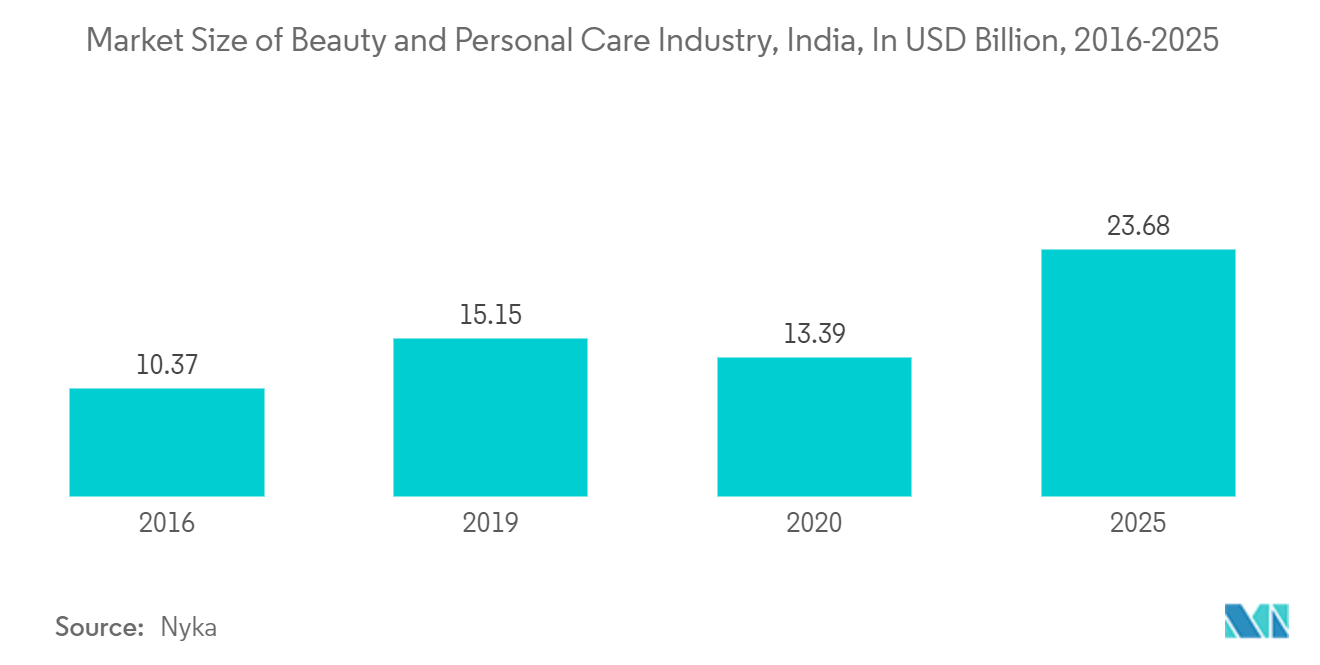
Enhanced Brand Engagement with Customers is Expected to Drive the Market
- Engaging customers is considered a crucial element for the market to maximize its potential. This entails utilizing omnichannel marketing to connect with a wider range of audiences. Customers are guided through each step of the marketing funnel through the use of marketing automation and personalized communication. By utilizing data-driven insights and implementing agile marketing tactics, brands can effectively enter the market. Numerous D2C enterprises are making substantial investments in diverse approaches to interact with customers.
- According to a recent study conducted by Data Labs, the direct-to-consumer (D2C) industry in India is experiencing rapid growth. It is projected to reach a market size of USD 100 billion by 2025. Over the past few years, an increasing number of businesses have opted to skip conventional retail avenues and are now directly selling their products to consumers via their online platforms, social media channels, and various digital mediums. Through the strategic use of social media, content marketing, influencer collaborations, and focused advertising efforts, companies in the area are successfully conveying their unique value propositions and enhancing customer interaction.
- For instance, Boat, a consumer electronics brand, became the quickest D2C brand to reach INR 100 crore in just two years. Another D2C fashion brand, Bewakoof, aims to achieve INR 2,000 crore in sales by 2025. These brands have quickly become popular among consumers due to their focus on customer engagement and personalized experiences. Furthermore, the rise of D2C brands is driven by their attention to tier-II and tier-III cities for sourcing materials and serving the underserved markets in these cities. These important factors are anticipated to stimulate the market.
- Footwear and clothing companies are making substantial investments in customer engagement through diverse marketing tactics. Neeman, for example, stands out as one of the rare shoe brands in India that has replaced synthetic fibers with organic materials. By recycling PET plastic bottles and rubber to create shoes, this eco-friendly footwear brand has garnered attention from both the media and environmentally conscious consumers. Neeman's customers consistently praise the brand for its comfortable, long-lasting, odor-free, and lightweight shoes that eliminate the necessity of wearing socks.
- The remarkable growth in the D2C e-commerce industry in India can be largely credited to the shift toward online shopping due to accessible internet, widespread smartphone usage, and evolving consumer preferences. With the rising internet connectivity in the region, D2C brands are expected to invest more in digital marketing efforts. As internet penetration expands, the presence of D2C brands across different sectors is set to increase in the country. The region is witnessing rapid growth in the adoption of the internet and growing investments in the production of smartphones.
- According to GSMA Intelligence, India had 1.10 billion cellular mobile connections at the beginning of 2023. In terms of 5G median download speeds, India ranked 14th globally with 301.86 Mbps based on Q4 2023 data. Additionally, with the support of the government's "Production Linked Incentive (PLI) Scheme," the region is experiencing significant growth in mobile phone manufacturing capabilities. It is on track to become the second-largest mobile manufacturing hub in the world. These developments are expected to create opportunities for direct-to-consumer (D2C) businesses in the region.
India D2C E-commerce Industry Overview
Many local firms have expanded in the Indian D2C e-commerce market, resulting in fierce competition. Some key players are Mamaearth, BoAt (Imagine Marketing Services Pvt. Ltd), and Bewakoof Brands Pvt. Ltd. Product launches, high expenses on R&D, and acquisitions and partnerships are the growth strategies adopted by such companies to sustain the intense competition.
- March 2024 - POP, an e-commerce company, announced the upcoming launch of a marketplace featuring a carefully selected collection of modern digital-first brands. Customers will have the opportunity to receive discounts by using reward currency. The company's goal is to establish this direct-to-consumer (D2C) marketplace through a straightforward approach, allowing brands to take advantage of valuable data and insights, as well as POPcoins. Additionally, the company plans to integrate everyday payments and direct-to-consumer e-commerce within its marketplace app, which is expected to revolutionize the industry.
- November 2023 - AJIO, the fashion e-commerce platform under Reliance Retail, introduced AJIOGRAM, a D2C-focused interactive online platform. The goal is to support Indian fashion startups that are pushing boundaries with their unique vision and innovative products. AJIO plans to collaborate with 200 local D2C brands in the upcoming year to provide customers with a diverse selection of styles ranging from streetwear to fast fashion, artisanal designs, minimalistic pieces, quiet luxury, and slow and sustainable fashion.
India D2C E-commerce Market Leaders
-
Mamaearth (Honasa Consumer Private Limited)
-
BoAt lifestyle (Imagine Marketing Services Pvt. Ltd.)
-
Licious (Delightful Gourmet Pvt Ltd.)
-
Melorra
-
Wakefit Innovations Pvt. Ltd.
- *Disclaimer: Major Players sorted in no particular order
India D2C E-commerce Market News
- April 2024: Aditya Birla Capital, the financial services division of the Aditya Birla Group, unveiled its omnichannel D2C platform ‘ABCD’. This move is part of the company's strategy to advance its digital transformation and aims to attract 30 million new users within the next three years. The introduction of ABCD signifies a major achievement for Aditya Birla Capital, signifying its transition into a comprehensive financial services provider.
- July 2023: Myntra, an e-commerce platform specializing in fashion, introduced an initiative aimed at boosting the expansion and reach of 200 Indian brands operating on a direct-to-consumer (D2C) model. The initiative, named 'Myntra Rising STARS,' is designed to enhance the D2C landscape in India. Through this program, Myntra will offer a range of support services to brands in the fashion, footwear, accessories, and home categories.
India D2C E-commerce Industry Segmentation
The market study includes the evolving customer journey across various online D2C models, key drivers influencing growth, challenges, and major technologies that will drive innovation in the Indian D2C e-commerce market. The market tracks the revenues accrued by companies selling directly to the customers through their own website or app without the intervention of any other third party.
The Indian D2C e-commerce market is segmented by end-user vertical. By end-user vertical, the market is segmented by apparel and footwear, grocery and gourmet, personal care, home décor and household supplies, healthcare, and jewelry. The market sizes and forecasts are provided in terms of value (USD) for all the above segments.
| By End-User Vertical | Apparel and Footwear |
| Grocery and Gourmet | |
| Personal Care | |
| Home Decor and Household Supplies | |
| Healthcare | |
| Jewelry |
India D2C E-commerce Market Research Faqs
How big is the India D2C E-commerce Market?
The India D2C E-commerce Market size is expected to reach USD 87.5 billion in 2025 and grow at a CAGR of 25% to reach USD 267.03 billion by 2030.
What is the current India D2C E-commerce Market size?
In 2025, the India D2C E-commerce Market size is expected to reach USD 87.5 billion.
Who are the key players in India D2C E-commerce Market?
Mamaearth (Honasa Consumer Private Limited), BoAt lifestyle (Imagine Marketing Services Pvt. Ltd.), Licious (Delightful Gourmet Pvt Ltd.), Melorra and Wakefit Innovations Pvt. Ltd. are the major companies operating in the India D2C E-commerce Market.
What years does this India D2C E-commerce Market cover, and what was the market size in 2024?
In 2024, the India D2C E-commerce Market size was estimated at USD 65.63 billion. The report covers the India D2C E-commerce Market historical market size for years: 2019, 2020, 2021, 2022, 2023 and 2024. The report also forecasts the India D2C E-commerce Market size for years: 2025, 2026, 2027, 2028, 2029 and 2030.
Our Best Selling Reports
India D2C E-commerce Industry Report
The India Direct-To-Consumer E-Commerce Market Report provides a comprehensive market overview, highlighting the significant market growth within various segments such as apparel and footwear, grocery and gourmet, personal care, home decor and household supplies, healthcare, and jewelry. The market analysis delves into the industry trends and offers a detailed market forecast, ensuring a thorough understanding of the market outlook.
This industry report includes valuable industry information and presents a detailed industry analysis, offering insights into the market size and market share. The report also features industry reports and research companies, providing a robust market review and industry research. The industry sales and industry size are meticulously examined, and the report includes industry statistics to support the analysis.
The market segmentation is thoroughly explored, giving a clear picture of the market value across different end-user verticals. The market data and market predictions are provided, ensuring that stakeholders are well-informed about the market dynamics. The report example and report PDF download offer a practical resource for further study and reference.
In addition, the market leaders in the India D2C E-commerce sector are identified, providing insights into the competitive landscape. The industry outlook is discussed, with a focus on future market trends and growth rate. The market trends and market growth are key highlights, showcasing the potential for expansion and development in this sector.
Overall, the India Direct-To-Consumer E-Commerce Market Report is a valuable resource that combines market research, industry overview, and market segmentation to deliver a comprehensive understanding of the market dynamics and future prospects.

